OCZ Agility 3 (240GB) Review
by Anand Lal Shimpi on May 24, 2011 2:53 AM ESTAnandTech Storage Bench 2011
I didn't expect to have to debut this so soon, but I've been working on updated benchmarks for 2011. Last year we introduced our AnandTech Storage Bench, a suite of benchmarks that took traces of real OS/application usage and played them back in a repeatable manner. I assembled the traces myself out of frustration with the majority of what we have today in terms of SSD benchmarks.
Although the AnandTech Storage Bench tests did a good job of characterizing SSD performance, they weren't stressful enough. All of the tests performed less than 10GB of reads/writes and typically involved only 4GB of writes specifically. That's not even enough exceed the spare area on most SSDs. Most canned SSD benchmarks don't even come close to writing a single gigabyte of data, but that doesn't mean that simply writing 4GB is acceptable.
Originally I kept the benchmarks short enough that they wouldn't be a burden to run (~30 minutes) but long enough that they were representative of what a power user might do with their system.
Not too long ago I tweeted that I had created what I referred to as the Mother of All SSD Benchmarks (MOASB). Rather than only writing 4GB of data to the drive, this benchmark writes 106.32GB. It's the load you'd put on a drive after nearly two weeks of constant usage. And it takes a *long* time to run.
I'll be sharing the full details of the benchmark in some upcoming SSD articles but here are some details:
1) The MOASB, officially called AnandTech Storage Bench 2011 - Heavy Workload, mainly focuses on the times when your I/O activity is the highest. There is a lot of downloading and application installing that happens during the course of this test. My thinking was that it's during application installs, file copies, downloading and multitasking with all of this that you can really notice performance differences between drives.
2) I tried to cover as many bases as possible with the software I incorporated into this test. There's a lot of photo editing in Photoshop, HTML editing in Dreamweaver, web browsing, game playing/level loading (Starcraft II & WoW are both a part of the test) as well as general use stuff (application installing, virus scanning). I included a large amount of email downloading, document creation and editing as well. To top it all off I even use Visual Studio 2008 to build Chromium during the test.
Update: As promised, some more details about our Heavy Workload for 2011.
The test has 2,168,893 read operations and 1,783,447 write operations. The IO breakdown is as follows:
| AnandTech Storage Bench 2011 - Heavy Workload IO Breakdown | ||||
| IO Size | % of Total | |||
| 4KB | 28% | |||
| 16KB | 10% | |||
| 32KB | 10% | |||
| 64KB | 4% | |||
Only 42% of all operations are sequential, the rest range from pseudo to fully random (with most falling in the pseudo-random category). Average queue depth is 4.625 IOs, with 59% of operations taking place in an IO queue of 1.
Many of you have asked for a better way to really characterize performance. Simply looking at IOPS doesn't really say much. As a result I'm going to be presenting Storage Bench 2011 data in a slightly different way. We'll have performance represented as Average MB/s, with higher numbers being better. At the same time I'll be reporting how long the SSD was busy while running this test. These disk busy graphs will show you exactly how much time was shaved off by using a faster drive vs. a slower one during the course of this test. Finally, I will also break out performance into reads, writes and combined. The reason I do this is to help balance out the fact that this test is unusually write intensive, which can often hide the benefits of a drive with good read performance.
There's also a new light workload for 2011. This is a far more reasonable, typical every day use case benchmark. Lots of web browsing, photo editing (but with a greater focus on photo consumption), video playback as well as some application installs and gaming. This test isn't nearly as write intensive as the MOASB but it's still multiple times more write intensive than what we were running last year.
As always I don't believe that these two benchmarks alone are enough to characterize the performance of a drive, but hopefully along with the rest of our tests they will help provide a better idea.
The testbed for Storage Bench 2011 has changed as well. We're now using a Sandy Bridge platform with full 6Gbps support for these tests. All of the older tests are still run on our X58 platform.
AnandTech Storage Bench 2011 - Heavy Workload
We'll start out by looking at average data rate throughout our new heavy workload test:

Our heavy workload has quite a bit of compressed reads/writes, which are where the Agility 3 is going to struggle the most. The 240GB Agility 3 performs more like an Intel SSD 510 here rather than a Vertex 3. The Agility 3 is still a respectable performer, definitely faster than the old Vertex 2, but it's definitely not as quick as the new Vertex 3.
The breakdown of reads vs. writes tells us more of what's going on:
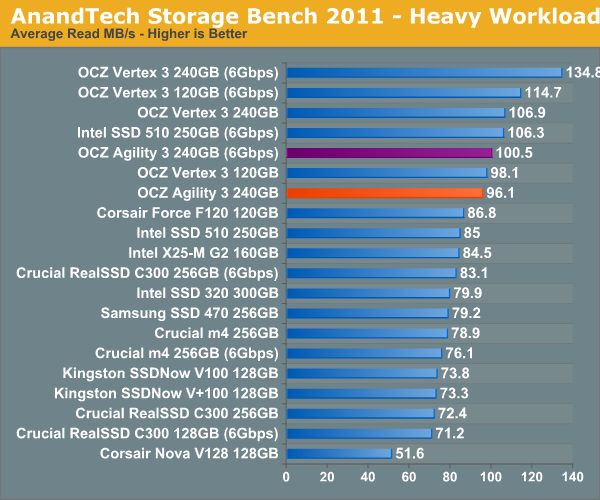
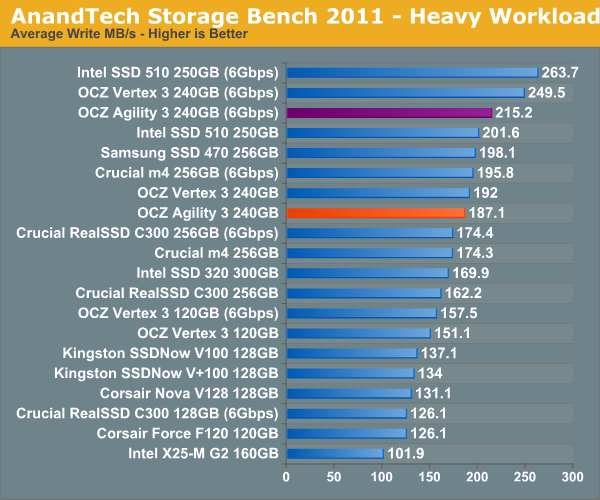
The next three charts just represent the same data, but in a different manner. Instead of looking at average data rate, we're looking at how long the disk was busy for during this entire test. Note that disk busy time excludes any and all idles, this is just how long the SSD was busy doing something:
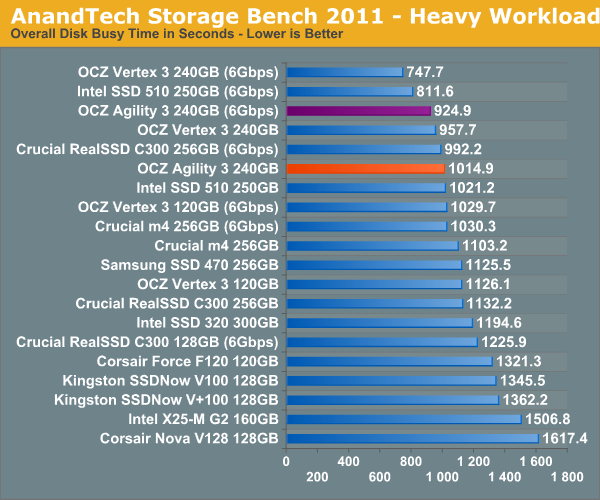
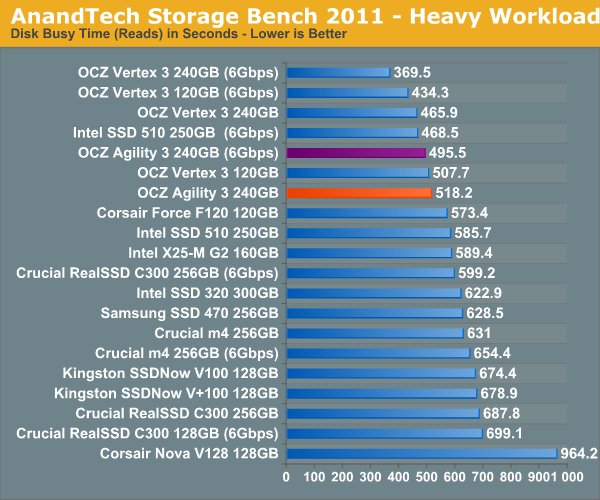
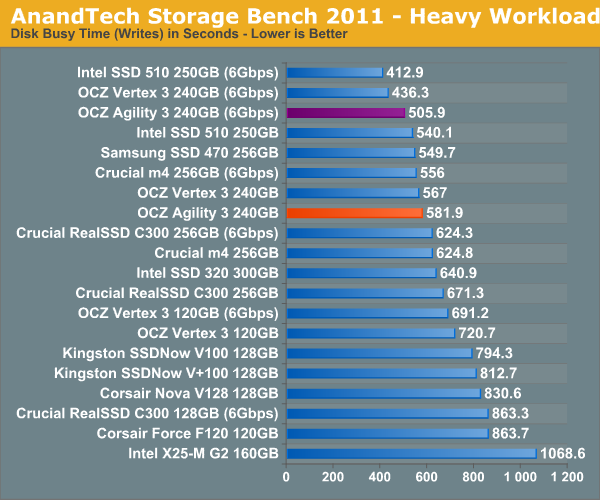










59 Comments
View All Comments
theagentsmith - Tuesday, May 24, 2011 - link
Corsair Force F115 154 Euros (1.34€/GB)OCZ Vertex 2E 120GB 175 Euros (1.46€/GB) don't know if it's a 25nm model
OCZ Agility 3 120GB 228 Euros (1.9€/GB)
OCZ Vertex 3 120GB 259 Euros (2.16€/GB)
Prices including VAT
Sure these new generation is faster, but there is barely any difference in a every day scenario, definitely not a night and day difference like a mechanical HD and a good SSD, so I prefer to pocket the savings to buy a F115 to another PC :)
OCedHrt - Tuesday, May 24, 2011 - link
Are the numbers in the "OCZ Vertex 3 240GB - Resiliency - AS SSD Sequential Write Speed - 6Gbps" chart on page 9 wrong? They don't match the conclusion: "The 240GB Agility 3 behaves similarly to the Vertex 3, although it does lose more ground after our little torture session."A 2-3% drop on Vertex 3 versus nearly 15% on Agility 3 is hardly behaving similarly. And the Agility 3 barely recovers after TRIM.
Mr Alpha - Tuesday, May 24, 2011 - link
For the TRIM test you fill the entire drive with incompressible randomly written data, and then TRIM it. It must take some time for the GC routine to actually clean up all those blocks. Does the time you wait before doing the after TRIM test affect the results you get?JasonInofuentes - Tuesday, May 24, 2011 - link
I think I understand what you're asking. You're wondering whether the time after the drive has been "deleted" and then left idle (for any amount of time) and thus allowed to engage in some amount of garbage collection, might be affecting the results. Certainly a possibility, which is why tests are run multiple times and averages reported.Great question, though. Thanks.
B0GiE - Tuesday, May 24, 2011 - link
I would like to see a 120Gb & 240Gb Shootout between the following:-Corsair Force Series 3
Corsair Force Series 3 GT
OCZ Vertex 3 Max IOPS
OCZ Vertex 3
OCZ Agility 3
Pretty Please!
icrf - Tuesday, May 24, 2011 - link
Agreed. I'm particularly interested in a 120 GB SSD, probably SF 2200 based. I bought an OCZ Vertex 2 @ 60G drive for boot/apps last fall, thinking I could stay within that, and have failed, so that's moved to the laptop and I'm looking for a 120G drive for the desktop.If the Corsair drives can really keep their pricing, they sound the most appealing. Specs sound very Vertex-like with pricing very Agility-like. I just want to see how some of these smaller drives fare with fewer NAND to deal with.
Oxford Guy - Tuesday, May 24, 2011 - link
The 240 GB Vertex 2!Shadowmaster625 - Tuesday, May 24, 2011 - link
"The original X25-M had 10 channels of NAND, giving it the ability to push nearly 800MB/s of data. Of course we never saw such speeds, as it's only one thing to read a few KB of data from a NAND array and dump it into a register. It's another thing entirely to transfer that data over an interface to the host controller."That's why I been saying they need to put a flash controller on the die. Imagine a dual sided DIMM with 8 NAND chips per side, each running ONFi 3.0 400MB/s. That's 6.4 GBps. zomg. It illicits a pavlovian response. 50 billion bits per second?
If intel was really interested in capturing the portable devices market, they'd be doing this. The tablet and smartphone SoCs all have integrated lpddr controllers, and look how fast they are for being such low bandwidth and low power.
bji - Tuesday, May 24, 2011 - link
I wonder if it's practical to put the controller on the die. Flash dies are highly optimized for flash, not general purpose processing transistors. Flash is usually a generation or so ahead of CPUs in the lithography process used because flash is simpler in its layout than CPUs. Putting a controller on a flash die would imply using the same lithography processes used for flash to be used for processing transistors and I just don't think that's likely to be feasable. Of course, flash controller logic would likely be alot simpler than a full x86 core. But I don't think that changes the fundamental impracticality of using flash process technology to create controller logic.bji - Tuesday, May 24, 2011 - link
Oh sorry I think I misunderstood you. You're talking about putting flash controllers on CPU dies, not on the flash dies, I think. In that case, I think that it's likely to be an inevitability. I predict that eventually permanent storage will look like DIMMs do now, like you said as sticks that you plug into slots in your motherboard just like you do for RAM now, and the controller will be built into the CPU to interface with them at high speed and operating systems will just see them as mapped to some memory range in the CPU address space. "Hard drives" will be a thing of the past, replaced by 'persistent memory'.